-
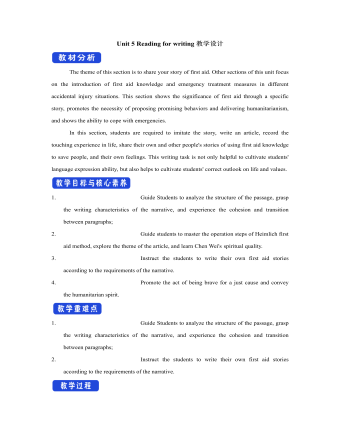
新人教版高中英语选修2Unit 5 Reading for writing教学设计
你校英语报计划出版一期急救常识专刊,现面向全校学生公开征集稿件,你有意参加。请你根据下面提示内容,用英语写一篇短文,介绍在车祸现场对伤者进行急救的方法和步骤。1.确保现场的安全;2.询问伤者,确保其呼吸正常;3.检查伤口,如流血则应采取止血措施;4.如需急救,确保其处于康复位置。注意:1.词数80左右;2.可以适当增加细节,以使行文连贯。参考词汇:康复位置 recovery positionAs we all know, having a knowledge of first aid can make a great difference in our daily life. If a traffic accident happens and someone is injured, the following steps can be used to treat the injured.In the first place, we should make sure that the accident scene is safe so that we won’t get hurt. We should ask the injured person if he is OK, and see if he is breathing. What’s more, we should check for cuts and wounds. If he is bleeding badly, it is vital that we should try to stop the bleeding by applying pressure to the injury. This is because if a person loses too much blood, he may die. If necessary, take the injured person to the hospital as soon as possible.Do remember: when giving first aid, please be sure to place the person in a recovery position.
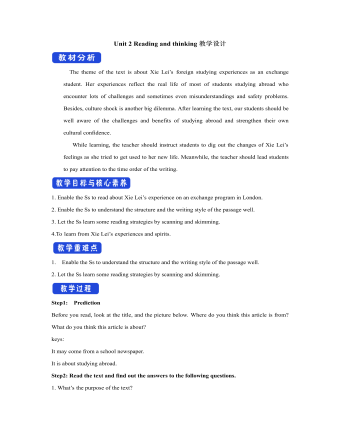
新人教版高中英语选修2Unit 2 Reading and thinking教学设计
Her tutor told her to acknowledge __________ other people had said if she cited their ideas, and advised her _______(read) lots of information in order to form __________wise opinion of her own.Now halfway __________ her exchange year, Xie Lei felt much more at home in the UK. She said __________ (engage) in British culture had helped and that she had been__________ (involve) in social activities. She also said while learning about business, she was acting as a cultural messenger __________(build) a bridge between the two countries. keys:Xie Lei, a 19yearold Chinese student, said goodbye to her family and friends in China and boarded (board) a plane for London six months ago in order to get a business qualification. She was ambitious(ambition) to set up a business after graduation. It was the first time that she had left (leave) home.At first, Xie Lei had to adapt to life in a different country. She chose to live with a host family, who can help with her adaptation (adapt) to the new culture. When she missed home, she felt comforted (comfort) to have a second family. Also Xie Lei had to satisfy academic requirements. Her tutor told her to acknowledge what other people had said if she cited their ideas, and advised her to read lots of information in order to form a wise opinion of her own.Now halfway through her exchange year, Xie Lei felt much more at home in the UK. She said engaging (engage) in British culture had helped and that she had been involved (involve) in social activities. She also said while learning about business, she was acting as a cultural messenger building a bridge between the two countries.
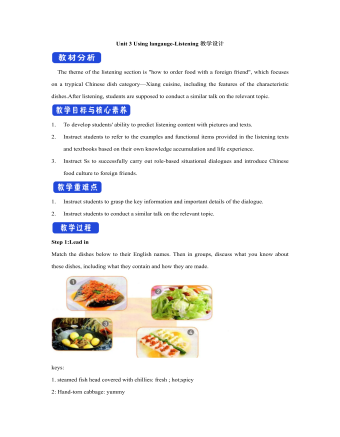
新人教版高中英语选修2Unit 3 Using langauge-Listening教学设计
1. How is Hunan cuisine somewhat different from Sichuan cuisine?The heat in Sichuan cuisine comes from chilies and Sichuan peppercorns. Human cuisine is often hotter and the heat comes from just chilies.2.What are the reasons why Hunan people like spicy food?Because they are a bold people. But many Chinese people think that hot food helps them overcome the effects of rainy or wet weather.3.Why do so many people love steamed fish head covered with chilies?People love it because the meat is quite tender and there are very few small bones.4.Why does Tingting recommend bridge tofu instead of dry pot duck with golden buns?Because bridge tofu has a lighter taste.5 .Why is red braised pork the most famous dish?Because Chairman Mao was from Hunan, and this was his favorite food.Step 5: Instruct students to make a short presentation to the class about your choice. Use the example and useful phrases below to help them.? In groups of three, discuss what types of restaurant you would like to take a foreign visitor to, and why. Then take turns role-playing taking your foreign guest to the restaurant you have chosen. One of you should act as the foreign guest, one as the Chinese host, and one as the waiter or waitress. You may start like this:? EXAMPLE? A: I really love spicy food, so what dish would you recommend?? B: I suggest Mapo tofu.? A: Really ? what's that?
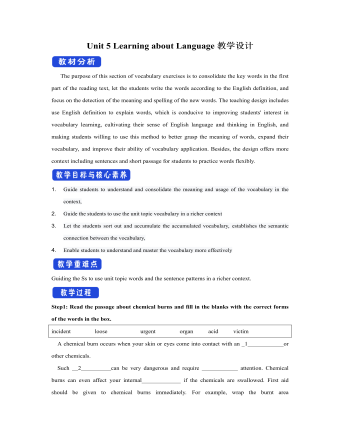
新人教版高中英语选修2Unit 5 Learning about Language教学设计
The purpose of this section of vocabulary exercises is to consolidate the key words in the first part of the reading text, let the students write the words according to the English definition, and focus on the detection of the meaning and spelling of the new words. The teaching design includes use English definition to explain words, which is conducive to improving students' interest in vocabulary learning, cultivating their sense of English language and thinking in English, and making students willing to use this method to better grasp the meaning of words, expand their vocabulary, and improve their ability of vocabulary application. Besides, the design offers more context including sentences and short passage for students to practice words flexibly.1. Guide students to understand and consolidate the meaning and usage of the vocabulary in the context, 2. Guide the students to use the unit topic vocabulary in a richer context3. Let the students sort out and accumulate the accumulated vocabulary, establishes the semantic connection between the vocabulary,4. Enable students to understand and master the vocabulary more effectivelyGuiding the Ss to use unit topic words and the sentence patterns in a richer context.Step1: Read the passage about chemical burns and fill in the blanks with the correct forms of the words in the box.
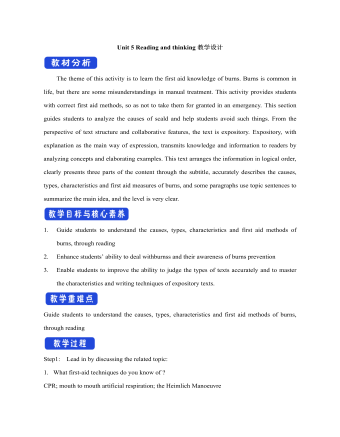
新人教版高中英语选修2Unit 5 Reading and thinking教学设计
The theme of this activity is to learn the first aid knowledge of burns. Burns is common in life, but there are some misunderstandings in manual treatment. This activity provides students with correct first aid methods, so as not to take them for granted in an emergency. This section guides students to analyze the causes of scald and help students avoid such things. From the perspective of text structure and collaborative features, the text is expository. Expository, with explanation as the main way of expression, transmits knowledge and information to readers by analyzing concepts and elaborating examples. This text arranges the information in logical order, clearly presents three parts of the content through the subtitle, accurately describes the causes, types, characteristics and first aid measures of burns, and some paragraphs use topic sentences to summarize the main idea, and the level is very clear.1. Guide students to understand the causes, types, characteristics and first aid methods of burns, through reading2. Enhance students’ ability to deal withburnss and their awareness of burns prevention3. Enable students to improve the ability to judge the types of texts accurately and to master the characteristics and writing techniques of expository texts.Guide students to understand the causes, types, characteristics and first aid methods of burns, through readingStep1: Lead in by discussing the related topic:1. What first-aid techniques do you know of ?CPR; mouth to mouth artificial respiration; the Heimlich Manoeuvre
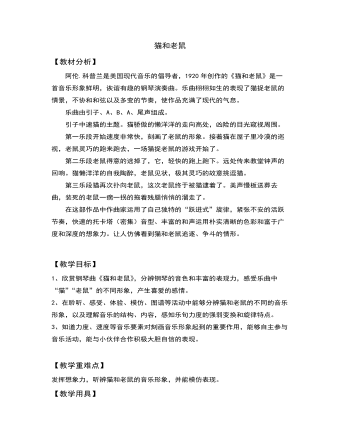
二年级音乐欣赏猫和老鼠教案教学设计
阿伦.科普兰是美国现代音乐的倡导者,1920年创作的《猫和老鼠》是一首音乐形象鲜明,诙谐有趣的钢琴演奏曲。乐曲栩栩如生的表现了猫捉老鼠的情景,不协和和弦以及多变的节奏,使作品充满了现代的气息。乐曲由引子、A、B、A、尾声组成。引子中速猫的主题。猫骄傲的懒洋洋的走向高处,凶险的目光窥视周围。第一乐段开始速度非常快,刻画了老鼠的形象。接着猫在屋子里冷漠的巡视,老鼠灵巧的跑来跑去,一场猫捉老鼠的游戏开始了。第二乐段老鼠得意的逃掉了,它,轻快的跑上跑下。远处传来教堂钟声的回响。猫懒洋洋的自我陶醉,老鼠见状,极其灵巧的故意挑逗猫。第三乐段猫再次扑向老鼠,这次老鼠终于被猫逮着了。美声慢板送葬去曲,装死的老鼠一瘸一拐的拖着残腿悄悄的溜走了。在这部作品中作曲家运用了自己独特的“跃进式”旋律,紧张不安的活跃节奏,快速的托卡塔(密集)音型、丰富的和声运用朴实清晰的色彩和富于广度和深度的想象力。让人仿佛看到猫和老鼠追逐、争斗的情形。
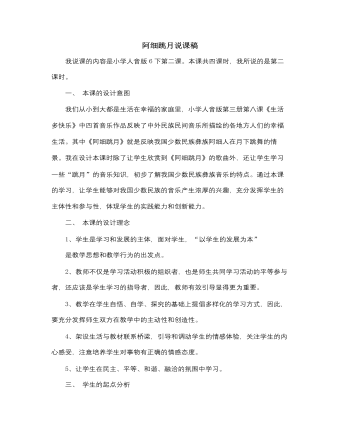
人音版小学音乐六年级下册阿细跳月说课稿
这一环节中,学生初步感受乐曲的主题旋律,学习“跳月”的舞蹈动作,并能够跟着琴来学唱《阿细跳月》的主题旋律。学生在这一环节中非常活跃,与教师的互动也很和谐。把课堂推上了一个小的高潮,不知不觉中解决教学难点。第三环节:听赏乐曲,复习巩固本环节设计三次让学生完整的欣赏乐曲。第一次让学生完整听,感受乐曲旋律的欢快跳跃的感觉,第二次听时让学生思考问题去听,第三次让学生跟着乐曲作“跳月”的动作。三次整的欣赏学生对《阿细跳月》又有了新的了解。第四环节:介绍乐曲,丰富知识学生对《阿细跳月》的了解非常的少,教师简单的介绍它的知识,再一次吸引学生的注意力,让学生对我国少数民族的音乐兴趣更加的浓厚。教师与学生一同跳起欢快的舞蹈,把课堂再次推向高潮。教师在高潮中结束本课。在这堂课中,学生愉快的学习了知识,充分发挥了他们的主体性和参与性,体现了学生的实践能力和创新能力。
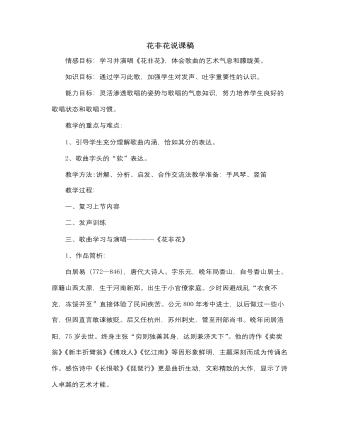
人音版小学音乐六年级下册花非花说课稿
朗读后,可请学生谈谈自己对这首诗的理解。教师还可抓住歌词中“花非花”、“ 雾非雾”和“夜半来、天明去”启发学生理解诗词所比喻的短暂易逝,难持长久的含义。5.有情感地吟诵歌词,体会词曲音调的紧密结合。可先请学生根据诗中每个字的声调,适当地放慢速度、延长韵母来吟诵,然后请一组同学吟诵一句歌词,一组同学哼唱一句旋律,其他同学对照。感知词的声调和旋律的音调之间的联系。6.学唱歌曲,表现歌曲的意境。在学唱时,教师要注意引导学生用轻柔、优美的声音来演唱。每个字的字头可唱得稍为、虚幻而柔美些,体现、朦胧诗的意境,唱好歌中的力度变化。注意气息的运用,尤其是最后一句“去似朝云无觅处”的渐慢与渐弱的处理,气息要控制好。四、拓展根据教学提示的要求,复习和交流学生已掌握的有关诗词歌曲,可以个人或设计小组演唱等多种表演形式,与同伴分享和分组展示。
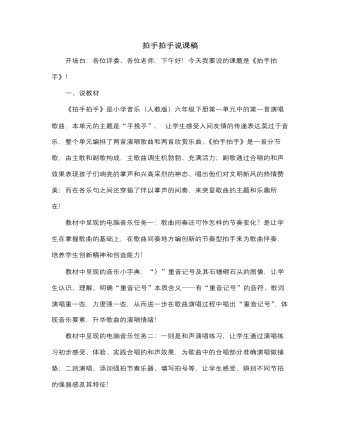
人音版小学音乐六年级下册拍手拍手说课稿
全体四人小组讨论编创间奏节奏变化,并进行练习!(巡视引导)之后,全体同学集中汇报各自小组的编创成果,如下:(1) X —(2) X X X其余同学评价该组的编创成果全体学生随乐用新的间奏节奏型拍手演唱歌曲(播放音乐)创造是发挥学生想象力和思维潜能的音乐学习领域,引导学生进行即兴式探究创造活动,是学生积累音乐创作经验和发掘创造思维能力的过程与方法。今天这节课,你有哪些学习收获?学生就会提出自己的收获,如:学会了这首歌曲《拍手拍手》,认识了“﹥”,知道了朋友间的友谊、友情是可以通过掌声来传递的……等等!引导学生对自己学习情况进行梳理和小结,明确各自在当堂课中的音乐学习信息,来促进今后的音乐学习质量和效率的提升!六、说板书我的板书设计是根据教学中需要和学生交流的关键知识点设计的,便于学生在总结学习收获时,梳理自己的音乐学习信息,明确学习重难点,并加深学习印象!
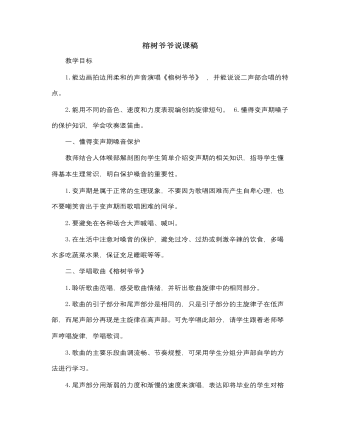
人音版小学音乐六年级下册榕树爷爷说课稿
1.能边画拍边用柔和的声音演唱《榕树爷爷》 ,并能说说二声部合唱的特点。2.能用不同的音色、速度和力度表现编创的旋律短句。 6.懂得变声期嗓子的保护知识,学会吹奏竖笛曲。一、懂得变声期嗓音保护教师结合人体喉部解剖图向学生简单介绍变声期的相关知识,指导学生懂得基本生理常识,明白保护嗓音的重要性。1.变声期是属于正常的生理现象,不要因为歌唱困难而产生自卑心理,也不要嘲笑音出于变声期而歌唱困难的同学。2.要避免在各种场合大声喊唱、喊叫。3.在生活中注意对嗓音的保护,避免过冷、过热或刺激辛辣的饮食,多喝水多吃蔬菜水果,保证充足睡眠等等。二、学唱歌曲《榕树爷爷》
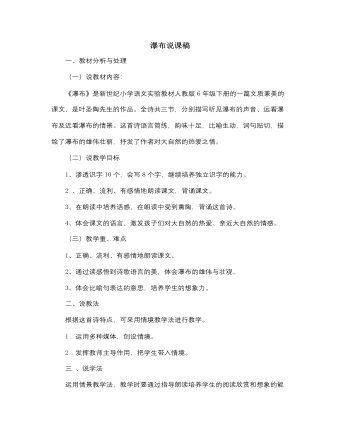
人音版小学音乐六年级下册瀑布说课稿
4、读第3小节。加快脚步,我们现在站到了瀑布的脚下。又看到了什么?自己读,想想瀑布又是怎样的?指名说。(示图)分别指导读好这两个句子。男女合作读这一小节。[这一段的学习,先引导学生想象,发展学生想象力;再适当运用多媒体,提升孩子的感悟,升华情感,引导孩子达到学文、入情的高潮。](四)以读代讲 情感升华瀑布多么美呀!再读,你会更加感受到它的美。下面我们随着动人的音乐,一起美美地读一读这首优美的诗歌吧!配乐齐读。大自然中还有很多象庐山瀑布这样美丽的风景,利用空闲时间,请你走进大自然,去欣赏更多的美景吧!(五)作业1、背诵小诗。(全体都完成)2、如果你愿意,画一画你亲眼见到的或者从电视等其他地方看到的瀑布,为它配上一首自己写的小诗。(自主选择)
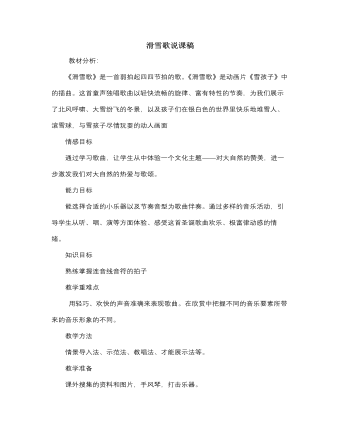
人音版小学音乐六年级下册滑雪歌说课稿
教材分析:《滑雪歌》是一首弱拍起四四节拍的歌。《滑雪歌》是动画片《雪孩子》中的插曲。这首童声独唱歌曲以轻快流畅的旋律、富有特性的节奏,为我们展示了北风呼啸、大雪纷飞的冬景,以及孩子们在银白色的世界里快乐地堆雪人、滚雪球,与雪孩子尽情玩耍的动人画面情感目标通过学习歌曲,让学生从中体验一个文化主题——对大自然的赞美,进一步激发我们对大自然的热爱与歌颂。能力目标能选择合适的小乐器以及节奏音型为歌曲伴奏。通过多样的音乐活动,引导学生从听、唱、演等方面体验、感受这首圣诞歌曲欢乐、极富律动感的情绪。知识目标熟练掌握连音线音符的拍子教学重难点用轻巧、欢快的声音准确来表现歌曲。在欣赏中把握不同的音乐要素所带来的音乐形象的不同。教学方法
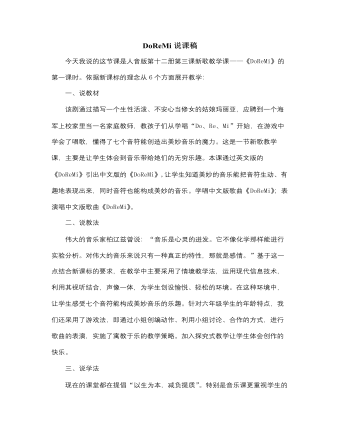
人音版小学音乐六年级下册DoReMi说课稿
1.通过欣赏《DO RE Mi》的影片,调动学生的积极性,增强学生学习新歌的兴趣。2.了解电影。任何一首歌曲都有着不一样的故事,通过文字简介,能够帮助学生深入歌曲的学习,升华表演的情绪。然后通过聆听歌曲《DO RE MI》,师范唱,生听唱,师指导唱的形式来帮助学生继续领略音乐的魅力。7.音乐游戏。不仅将学生分成七个小组跟琴演唱,还让学生根据伴奏完成歌曲接龙,充分体现了学生在课堂中的主体性。8.拓展开发。通过了解柯尔文手势,电影的背景资料和歌曲《孤独的牧羊人》的欣赏,提高学生的能力。第二环节既是这节课的重点,也是难点,通过引导学生运用手势音阶和肢体语言来表演歌曲《DoReMi》,又通过小组合作的方式突破难点。最后小结,简单地总结了同学们的表演让所有人感受到音乐带给我们的无穷乐趣,七个音乐字母构成了美妙的音乐,最后在美妙的音乐中结束了这节课!
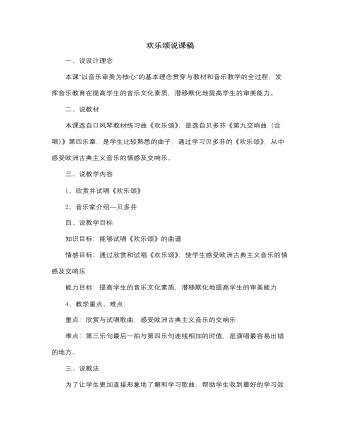
人音版小学音乐六年级下册欢乐颂说课稿
2、视频欣赏进入重点突破难点a、在这个环节我会播放电脑课件,让学生视听欣赏本曲,引导学生在参与欣赏音乐的活动中探索发现,深化情感体验。这是本课的重点。b、视听之后让学生用跟唱法学习歌曲,用“la”模唱,由于这首歌曲调很单纯,4/4拍子,所以学生完全有能力独立学会它。但能够完全无误地演唱好歌曲第三乐句最后一拍与第四乐句连线相加的时值便是本曲要突破解决的难点。在这个地方我会乐曲重复播放,利用电脑直接点击循环再现,为课堂省下不必要浪费的时间。这个环节我会对学生演唱歌曲进行检测,看是否已经解决了难点。方法有:A.全班同学或分组模唱B.个别模唱难点旋律C.难点旋律数、打拍子3、曲谱的试唱试唱曲谱强化学生听觉训练。美国作曲家、音乐教育家艾伦?科普兰说:“如果你要更好地理解音乐,再也没有比倾听音乐更重要的了。”
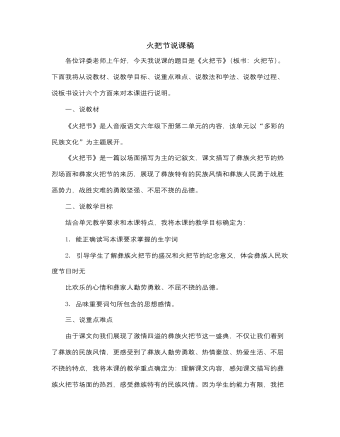
人音版小学音乐六年级下册火把节说课稿
同学们,看了这个传奇故事,那你们知道彝族人身上都体现了一个怎样的精神品质呢?此问题的设计既调动了学生的发散性思维,又可培养学生对彝族人精神品质的敬畏之情。环节5:研读赏析新课标中明确指出:“阅读是学生个性化的行为,不应以教师的分析来代替学生的阅读实践。”教师给学生充足的时间,让学生带着感情读出你喜欢的句子或段落,说出自己喜欢 的理由或者感受。其他学生可以适时做补充,或者引发讨论,让学生在积极主动的思维和讨论中,加深理解和体验,有所感悟和思考,从而受到情感熏陶获得思想启迪,进而解决教学难点。环节6拓展延伸1.写一个场面描写。2.用你喜欢的方式表达你的情感发挥学生想象力,理论-实践,学以致用。六、说板书设计好的板书就像一份微型教案,此板书力图全面而简明的将授课内容传递给学生,清晰直观,便于学生理解和记忆,理清文章脉络。
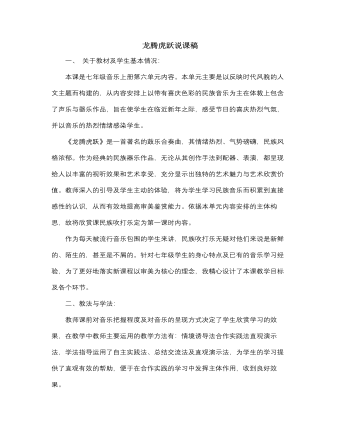
人音版小学音乐六年级下册龙腾虎跃说课稿
聆听感悟—本环节是模式实施的重要环节,也是围绕新课程理念提高审美,落实教学目标的关键。在此,从学生学习的角度出发,又细化为三个步骤具体实施:1、初步感知2、深入体验3、复听感悟。这三个步骤的实施目的在于,使得学生对于音乐的体验和感悟呈现出一个由表及里循序渐进的过程。先是使学生获得初浅的整体印象,再由教师精心选择设计特色音乐片段共同聆听体验,并引导启发学生感悟音乐,使学生逐步积累一些欣赏音乐的知识,有意识地将听觉、音乐理论及自身感悟巧妙融合,形成学习和鉴赏的基本方法,从而提高对于音乐的感悟和鉴赏能力。其中复听感悟环节往往会受到乐曲篇幅及时间所限制,如本课《龙腾虎跃》一曲,如果完整欣赏一次需八分多钟的时间,因此,考虑到学生学习民乐的经验和实际情况,故作调整:将总体感悟乐曲放到第二课时进行。
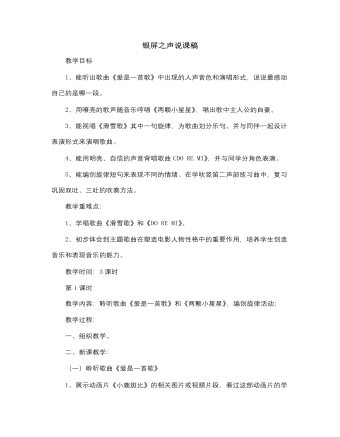
人音版小学音乐六年级下册银屏之声说课稿
2、初听歌曲,听出歌曲中出现的人声音色和演唱形式。聆听前,教师与学生一起回顾人声的分类和学过的演唱形式有哪些,并把这些知识写在黑板上,便于学生在聆听时对照。歌曲先是由男声领唱,接着是男女声合唱。3、复听歌曲,听后让学生说说歌中的哪一段最能感动自己。引导学生从歌名和歌词中谈谈对歌曲的理解,结合歌曲的演唱形式“领唱与合唱”所体现的效果,体会歌曲最令人感动的部分。4、再次聆听,感受歌曲所表达的甜美与温馨。(二)聆听歌曲《两颗小星星》1、从复习演唱歌曲《小小少年》人手,简单回忆德国影片《英俊少年》的故事情节,并让学生谈谈对主人公海因切的印象。2、初听歌曲,,感受歌曲的情绪。教师引导学生从歌曲的节奏型与一字一音中,感受主人公海因切的自信与自豪的性格特点。还请学生听出不同情绪的两个乐段,为后面编创活动做铺垫。
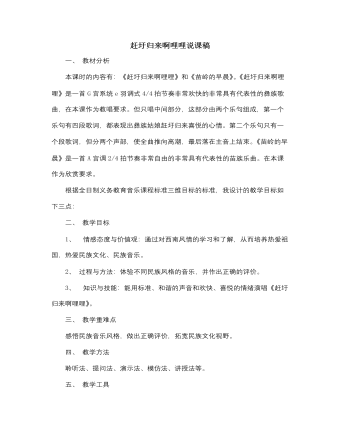
人音版小学音乐六年级上册赶圩归来啊哩哩说课稿
我使用的是聆听法和提问法。请同学们带着这样的问题欣赏《苗岭的早晨》。问题是“听这首乐曲时你眼前浮现的是什么样的画面?这首乐曲表达了怎样的思想感情?”听完后作答。我这样设计的目的是实现我的第二点教学目标。这个环节完后我接着对苗族的重要节日、服饰、音乐、乐器和一些风俗习惯等进行阐述。运用讲授法和讨论法。这样设计的目的是实现我的第一点教学目标。3、 教唱部分:(18分钟)不同的少数民族,他会具有自己独特的民族文化和音乐风格。让我们一起来学习一首很有魅力的彝族歌曲《赶圩归来啊哩哩》。首先我们完整地听一遍,感受一下这首曲子的情绪和独特的地方。接着就是教唱和演唱、分组演唱的部分。这样设计的目的是实现我的第三点教学目标。4、 小结:“今天我们叩开了西南风情的大门,发现里面绚丽多彩如诗如画。希望同学们通过网络和书籍等手段继续参观和探索里面的奥妙。”这样设计的目的是让同学们继续学习。最后结束本课。
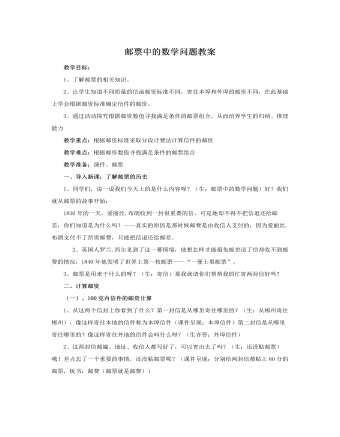
人教版新课标小学数学六年级下册邮票中的数学问题教案
《贴邮票》活动要求:A、每组4人,给四封不同地点、质量的信件B、根据信封上的信息计算邮费并按要求贴上邮票(邮票的总面值刚好等于邮费,不能多贴)每封信最多贴三张邮票,只有0.8元或1.2元的两种邮票纪律要求:看看哪组合作得最好,速度最快!如果遇到困难,在事发那个在一边最后再去解决。3、小组汇报(1)、贴邮票的过程中大家遇到了什么问题?(有的能贴有的不能贴)这样的信件有哪些?(告诉我地点、质量、邮费)(2)、其他的信件都能贴出来嘛?说说看你是怎么贴邮票的?(3)、请将你们贴好邮票的信件送到邮箱来。剩下的都是一些“难题”(4)、思考:为什么4.0元、4.8元、6元的邮费没有办法按要求贴出邮票?(5)、原因出在哪里?这个问题怎么解决?(邮票面值太小,将邮票的面值改大)(6)、那最少要改成多大的?为什么?(将邮票面值改大,你会从多大面值的邮票开始考虑?为什么?)
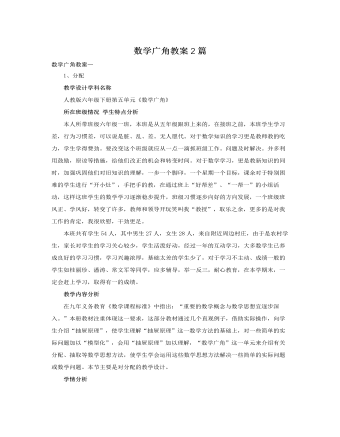
人教版新课标小学数学六年级下册数学广角教案2篇
一、创设情境,猜想验证1.猜一猜,摸一摸。一盒粉笔若干支,5种不同的颜色。至少摸几支能保证:(1)2支同色的。(2)3支同色的。(3)4支同色的。2.想一想,摸一摸。请学生独立思考后,先在小组内交流自己的想法,再动手操作试一试,验证各自的猜想。在这个过程中,教师要加强巡视,要注意引导学生思考本题与前面所讲的抽屉原理有没有联系,如果有联系,有什么样的联系,应该把什么看成抽屉,要分放的东西是什么。二、观察比较,分析推理1.说一说,在比较中初步感知。2.想一想,在反思中学习推理。三、深入探究,沟通联系四、对比练习,感悟新知1.说一说。把红、黄、蓝、白四种颜色的球各10个放到一个袋子里。至少取多少个球,可以保证取到两个颜色相同的球?2.算一算。向东小学六年级共有370名学生,其中六(2)班有49名学生。请问下面两人说的对吗?为什么?五、总结评价六、布置作业

